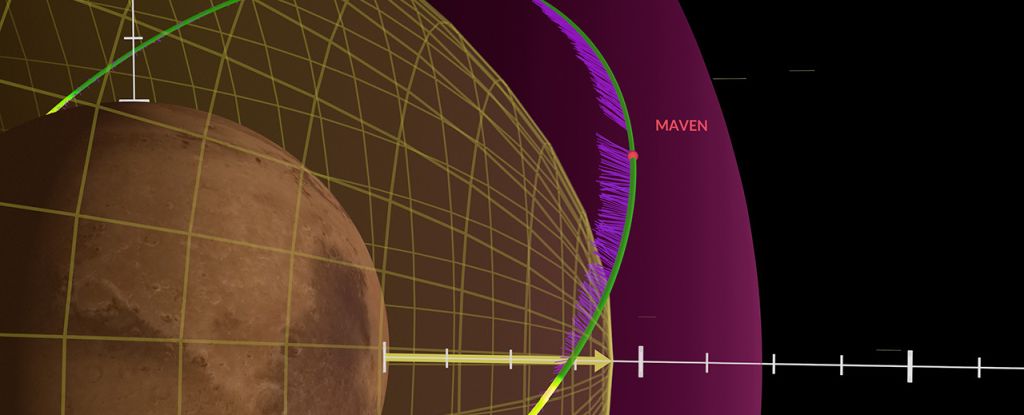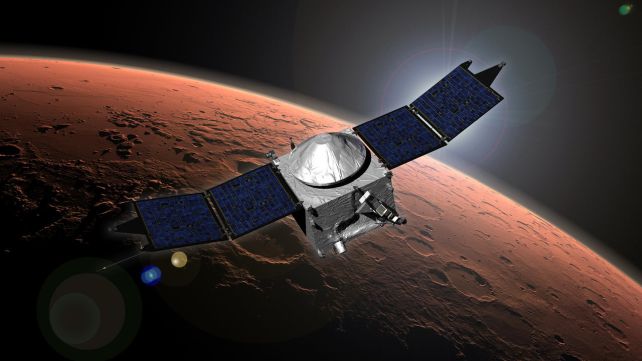
An unusual void, created by an intense burst of solar wind, triggered a remarkable expansion of Mars’ atmosphere. The MAVEN spacecraft, in its orbit around the Red Planet, detected a sudden and significant decrease in solar particles on December 26, 2022. Simultaneously, it observed a peculiar and dramatic alteration in the Martian atmosphere, with the planet’s magnetosphere and ionosphere expanding by thousands of kilometers, surpassing triple its usual size.
This rare occurrence harks back to 1999 when a comparable drop in solar wind caused Earth’s magnetosphere to undergo a substantial increase, expanding its volume 100-fold.
Providing a unique insight into Mars’ response to abrupt changes in Solar System conditions, this event may offer valuable knowledge on how planets resembling Earth in the Solar System interact within varying stellar environments.
Furthermore, it underscores the significance of deploying spacecraft in close proximity to diverse worlds in our Solar System. These in-situ measurements enable us to better comprehend the intricate interactions between planets and their surroundings.

Upon analyzing the data, astronomer Jasper Halekas from the University of Iowa, the lead author of a new study on the event, expressed disbelief at the remarkable drop in solar wind intensity. “We formed a working group to study the event, and we have found this time period to be rich with incredible findings,” Halekas shared.
The solar wind, a constant in the Solar System, envelops all planets within its stream of particles emanating from the Sun. This continuous outflow generates ambient pressure throughout the Solar System, diminishing with distance and eventually dissipating at the heliopause, a recognized boundary.
Despite its consistency, the solar wind’s strength can vary with solar activity. Instances of weakened solar magnetic fields on the Sun’s surface, for example, can result in a more forceful solar wind, showering the system with intensified and numerous solar particles.
The solar wind encounter with Mars on December 26, 2022, presented a unique scenario. It comprised two solar winds – a slower one absorbed by a faster wind from behind, forming a singular, super wind as it continued outward.
MAVEN meticulously recorded the higher particle density from this dual solar wind. Following its passage, the orbiting observatory detected an unprecedented drop in particle density, marking a rare void characterized by an extremely weak and low-density solar wind. Simultaneously, there was a substantial decrease in solar wind pressure, with density plummeting by a factor of 100 and pressure by a factor of 10.
With the diminishing pressure around it, the Martian atmosphere underwent a notable response.
The typical action involves the solar wind exerting pressure on a planet’s magnetosphere, a phenomenon primarily fueled by the internal churning of molten materials on planets like Earth. Although Mars lacks its own comprehensive magnetosphere, it possesses what scientists refer to as an induced magnetic field. This magnetic field is formed as magnetic fields within the solar wind become entangled in Mars’ ionosphere.
The ionosphere, along with the induced magnetic field, expanded significantly outward, akin to the Martian atmosphere releasing itself from a constricting corset. The induced magnetic field lost its magnetization, resulting in a notably tranquil bow shock – the region between it and the solar wind.
Researchers suggest that this occurrence provides valuable insights into the mechanisms of atmospheric loss on Mars and similar planets throughout the galaxy. Understanding these processes is crucial in deciphering the factors contributing to a planet’s habitability.
“We are truly witnessing how Mars reacts when the solar wind is effectively diminished,” Halekas explains. “This serves as an exceptional case study, offering a glimpse of what Mars might be like if it orbited a less ‘windy’ star.”
The team is set to present its findings at the American Geophysical Union Fall Meeting 2023.





